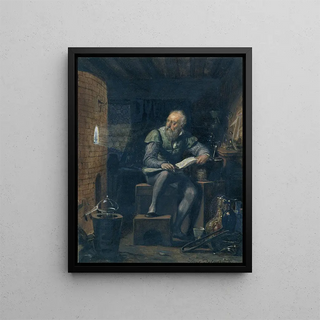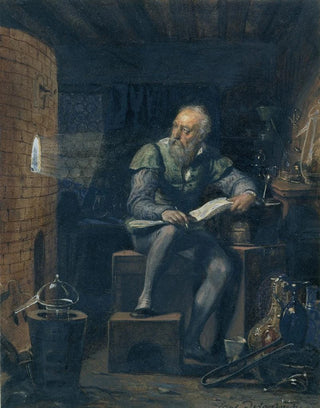Art print | Palissy in his workshop - Paul Delaroche


View from behind

Frame (optional)
In the fascinating world of art, some works manage to capture not only the eye but also the imagination. "Palissy dans son atelier" by Paul Delaroche is one of these masterful pieces. This canvas, created in the 19th century, immerses us in the intimacy of a creator, Bernard Palissy, a renowned French ceramicist and naturalist. Through this artwork, Delaroche offers us a window into the past, where art and science meet in a vibrant dialogue. The painting evokes an atmosphere charged with emotion, inviting the viewer to explore the thoughts and passions of this iconic artist.
Style and uniqueness of the work
Paul Delaroche's style is distinguished by its striking realism and its ability to convey deep emotions. In "Palissy dans son atelier," every detail is carefully executed, from the textures of the materials to the expressions of the characters. Light plays a crucial role in this composition, illuminating Palissy's face while creating shadows that add depth to the scene. The atelier, rich in art objects and instruments, becomes a true character in its own right, bearing witness to Palissy's obsession with nature and beauty. This artwork is not just a static representation; it tells a story, that of a man dedicated to his quest for truth and innovation. Thus, the art print of this piece allows for rediscovering the intensity of artistic passion.
The artist and his influence
Paul Delaroche, a prominent figure of French Romanticism, knew how to mark his era with works that blend history and emotion. His innovative approach to historical painting influenced many artists, both through his technique and his choice of subjects. By choosing to depict an artisan rather than a traditional hero, Delaroche challenged the norms of his time and highlighted the value of manual work and creativity. The depiction of Palissy, a man whose contributions to art and science have often been overlooked, testifies to the artist's commitment to celebrating lesser-known but equally important figures in history. This artwork, while a personal representation, becomes a manifesto for the recognition of art.

Matte finish

View from behind

Frame (optional)
In the fascinating world of art, some works manage to capture not only the eye but also the imagination. "Palissy dans son atelier" by Paul Delaroche is one of these masterful pieces. This canvas, created in the 19th century, immerses us in the intimacy of a creator, Bernard Palissy, a renowned French ceramicist and naturalist. Through this artwork, Delaroche offers us a window into the past, where art and science meet in a vibrant dialogue. The painting evokes an atmosphere charged with emotion, inviting the viewer to explore the thoughts and passions of this iconic artist.
Style and uniqueness of the work
Paul Delaroche's style is distinguished by its striking realism and its ability to convey deep emotions. In "Palissy dans son atelier," every detail is carefully executed, from the textures of the materials to the expressions of the characters. Light plays a crucial role in this composition, illuminating Palissy's face while creating shadows that add depth to the scene. The atelier, rich in art objects and instruments, becomes a true character in its own right, bearing witness to Palissy's obsession with nature and beauty. This artwork is not just a static representation; it tells a story, that of a man dedicated to his quest for truth and innovation. Thus, the art print of this piece allows for rediscovering the intensity of artistic passion.
The artist and his influence
Paul Delaroche, a prominent figure of French Romanticism, knew how to mark his era with works that blend history and emotion. His innovative approach to historical painting influenced many artists, both through his technique and his choice of subjects. By choosing to depict an artisan rather than a traditional hero, Delaroche challenged the norms of his time and highlighted the value of manual work and creativity. The depiction of Palissy, a man whose contributions to art and science have often been overlooked, testifies to the artist's commitment to celebrating lesser-known but equally important figures in history. This artwork, while a personal representation, becomes a manifesto for the recognition of art.






